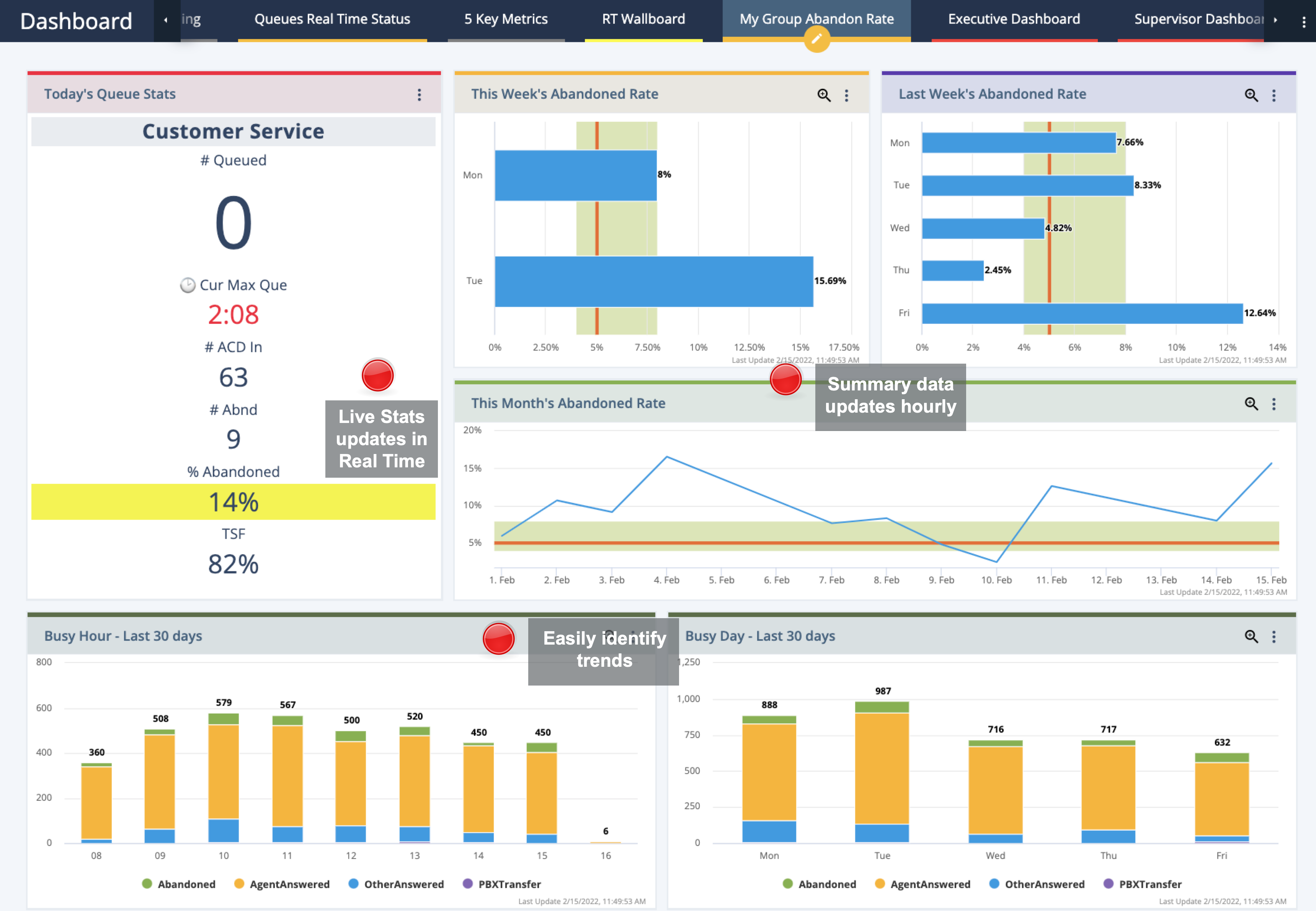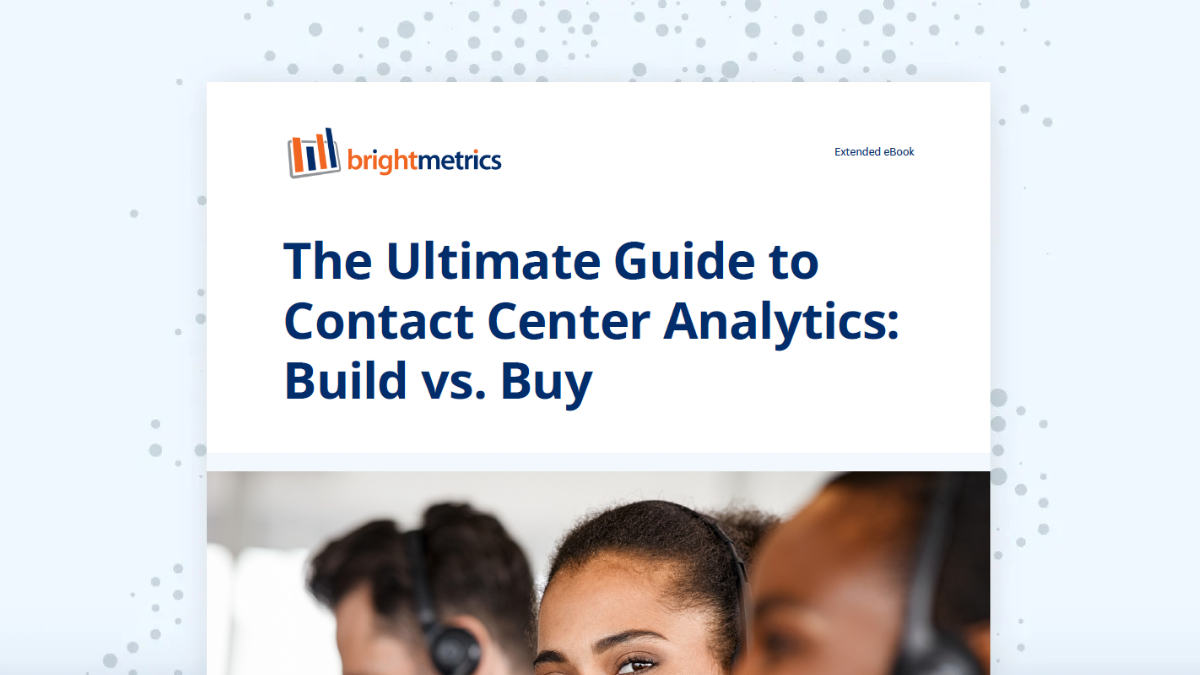TL;DR: An abandoned call is one where the caller hangs up before being connected to a live agent where they would normally get an opportunity to receive assistance and/or resolve their issue. Four ways to improve your call abandonment rate are by understanding your staffing levels, implementing a callback system, optimizing your website, and reviewing your IVR.
We have all been there. You finally get a few minutes to make the call you have been putting off all week. You dial in and get put on hold. After waiting for what feels like an eternity you give up and hang up the phone, abandoning your call. A company’s call center abandonment rate is one of the most important key metrics to monitor and also one of the simplest to improve with the right modifications to your procedures.
We know as consumers how frustrating this type of experience can be. As a team that develops software that analyzes and visualizes your contact center’s customer engagements, we at Brightmetrics™ know that these experiences can have negative consequences not only for bottom lines but also for a brand’s reputation.
What Is a Call Abandon Rate?
Abandonment rate is a key metric you will hear in conversations about call center management and customer service. Understanding what an abandoned call is and how they impact customer experience (more on that later) are pivotal parts to understanding why call abandonment rates matter.
So what are abandoned calls? An abandoned call is one where the caller hangs up before being connected to a live agent where they would normally get an opportunity to receive assistance and/or resolve their issue.
How To Calculate Call Abandonment Rate?
The call center abandonment rate formula is the calculation of the number of calls where the customer hangs up before their call is answered by an agent, divided by the number of inbound calls offered. Inbound calls are the number of calls that come into your call center by your clients or customers that are intending for an outcome and are unable to get to the outcome they desire.
See below:

It is also important to note what is not included when calculating call abandonment rates:
- Dropped Calls – Calls that are unwittingly disconnected by the call center most often because of technical errors. Hopefully, these are seldom occurrences.
- Callback Requests – Callers opt for a callback when an agent is available rather than continuing to wait in a queue.
- Short Calls – When a caller hangs up shortly after speaking with an agent. These are typically not included in any numbers for abandonment.
- Interflowed or Overflowed Calls – Calls that wait in a queue for so long that the system routes the call to another group that may be available when the max wait time is met.
- Transferred Calls – Calls transferred from one group to another are not counted as abandoned calls unless the caller hangs up, at which time the abandoned call is counted against whichever group the caller was waiting for at that time.
We also want to mention that just because your contact center has achieved a “low” call abandonment rate overall, it may not correlate to customer satisfaction. It is entirely possible that one customer calls in five times and completes five interactions without abandoning but only got their helpful, resolution-affirming answer on the fifth call. We do not think anyone’s goal for customer experience is to get it right after multiple attempts so of course keep in mind that abandon rates are a part of a larger picture. First call resolution and reducing the number of calls made about the same issues are best practices within call centers regardless of abandonment rates.
What Is the Call Center Abandonment Rate Industry Standard?
What is considered an acceptable abandon rate in call centers can vary by sector, but generally speaking an average abandon rate in call centers is between 4% and 8%. Lower than 4%, you run the risk of being overstaffed which can unnecessarily increase your overhead costs. Anything above 8% would be considered a high call center abandonment rate. At these higher percentages, you see a critical decline in customer and contact center agent satisfaction.
Contact center managers are often targeting an “ideal” abandon rate in their operations because there is an intersecting relationship between abandonment rates and cost per contact figures and customer satisfaction.
4 Tips To Improve Your Abandonment Rate
It is normal that your call abandonment rate will vary for a multitude of reasons. Factors such as time of day, peak business season, service level performance, queue strategy (ie. utilizing on-hold messaging, hold music, call back options, etc.) However, with a few tweaks, you can improve your abandonment rate or improve your abandonment rate forecasting.

1. Understand Staffing Levels
This is a really common tip but it is often overlooked in conversations because of the simplicity. Having an understanding of peak seasons and peak times of day and making appropriate staffing calls can hugely impact a call center’s abandonment rate. If a customer is on hold for an absorbent amount of time they are likely to abandon the call and being properly staffed can help with wait times.
If you’d like to learn more about managing your call center’s staffing levels, watch this video.
2. Implement Callbacks
Giving your customers options for how they want to be serviced can lead to improved client experiences. Nobody enjoys feeling like they are “wasting time” when they are trying to get a resolution for issues. No company wants its brand to be associated with lackluster service and extended wait times. Giving your customers the option to get a call back instead of forcing them to remain on the phone can go a long way in improving your call-back rates.
3. Optimize Self-Service Functionality On Your Website
This tip may be a surprise, but it comes down to understanding the journey of your customer who has a question or concern. Your website can influence your conversion rate, abandoned cart rates, the total number of customer contacts, lost sales, and influence your potential customers. A poorly designed website can also contribute to high abandonment rates for phone calls.
Are your customers calling you because they thought they could not find the answer to their question on your website but while they were on hold they clicked into the internal pages of your website and found the answer so they abandoned the call?Understanding the steps your customers are taking helps you manage the touchpoints and pain points. Sometimes having something as simple as a robust FAQ page that is on the homepage can prevent an abandoned call.
4. Reviewing Your IVR
Think your Interactive Voice Response (IVR) is straightforward? Are you monitoring how many transfers happen with one contact? Understanding the number of layers and complexities within your system and looking for ways to simplify processes within the IVR can be a relatively straightforward process to improve your abandonment rate. This can also be an opportunity to take the journey of your customer like mentioned above and look for ways to hone messaging and predictive behavioral routing can be hugely impactful to elevate customer support.
No Call Abandoned, Our Final Points on Abandon Rate
At Brightmetrics we are big believers in giving our clients the big picture with the sharpest details so that you get the full context in contact center operations. Abandon rates are one of those tricky KPIs that are looked at often without the larger context so we hope that this blog spotlighted some of the interconnectivity between design, experience, and customer satisfaction levels.
In the end, it is critically important to understand that your call center abandonment rate is an important metric. Answering questions, addressing concerns, and delivering positive mission-aligning experiences for your customer base is what is all about.
Improve Your Abandon Rate with Brightmetrics
Brightmetrics is designed to help your team gain critical insights into the performance of your contact center by identifying key performance indicators and metrics, and how they directly impact your customer’s experience. We offer high-level dashboards and call summary reports to help you drill-down interaction features. We show you the high-level trends developing within your call center giving you insight into nitty-gritty details giving you the power to give you what you need to forecast and make intelligent business decisions backed by data. Brightmetrics can easily help teams optimize scheduling and sharpen forecasting which, as we mentioned above, can help strike that balance for an optimal abandonment range. We can help streamline communication with your teams and unify the operations of your call center.
We know our clients across all industries are focused on strengthening relationships with their clientele and reinforcing positive habits with their call center agents. Our dashboards and reports help call center teams to take the guesswork out of extracting strategic insights from their customer data. Implementation is fast and straightforward.
Get started with a free trial today!

Additional FAQs
What Does Abandon Time Mean?
Abandon time is the average amount of time your customers are willing to wait for an agent to answer before hanging up.
What Is a Short Abandoned Call?
Oftentimes a short abandoned call is a call that is abandoned within less than five seconds of entering the queue. This timing is often configurable in the call center software.
What Is the Average Speed of Answer (ASA)?
The Average Speed of Answer or ASA is the average amount of time your customers are waiting to speak to an agent once in the queue. Most call centers strive for an ASA of 20-30 seconds. However, ASA can also at times be longer than 30 seconds depending on the industry or time of year. The important thing is to track this metric on an ongoing basis, watching for trends and anomalies that may degrade customer satisfaction.
What Is the Average Handle Time in Call Centers?
Average Handle Time is the total time the agent spends on calls (including talk time, hold time, Wrap, or After Call Work) divided by the number of calls answered.
What Is an Acceptable Hold Time in a Call Center?
Like above this answer varies with industry and expert insight. You will commonly see recommendations of between 30 seconds and 2 minutes for acceptable time frames for hold times. However, it is often considered best practice for an agent to check back in every at least every two minutes with a customer who is on hold so that the customer doesn’t hang up and call right back.



